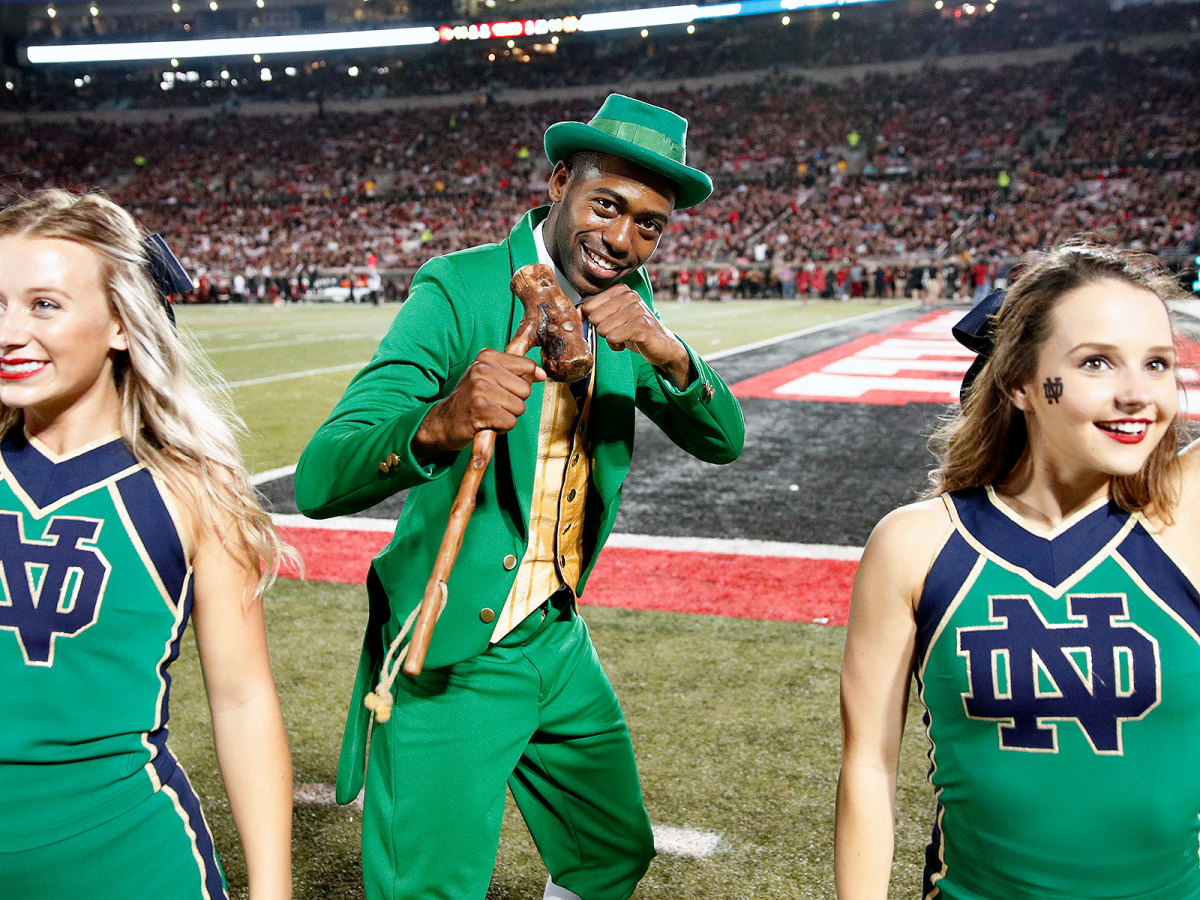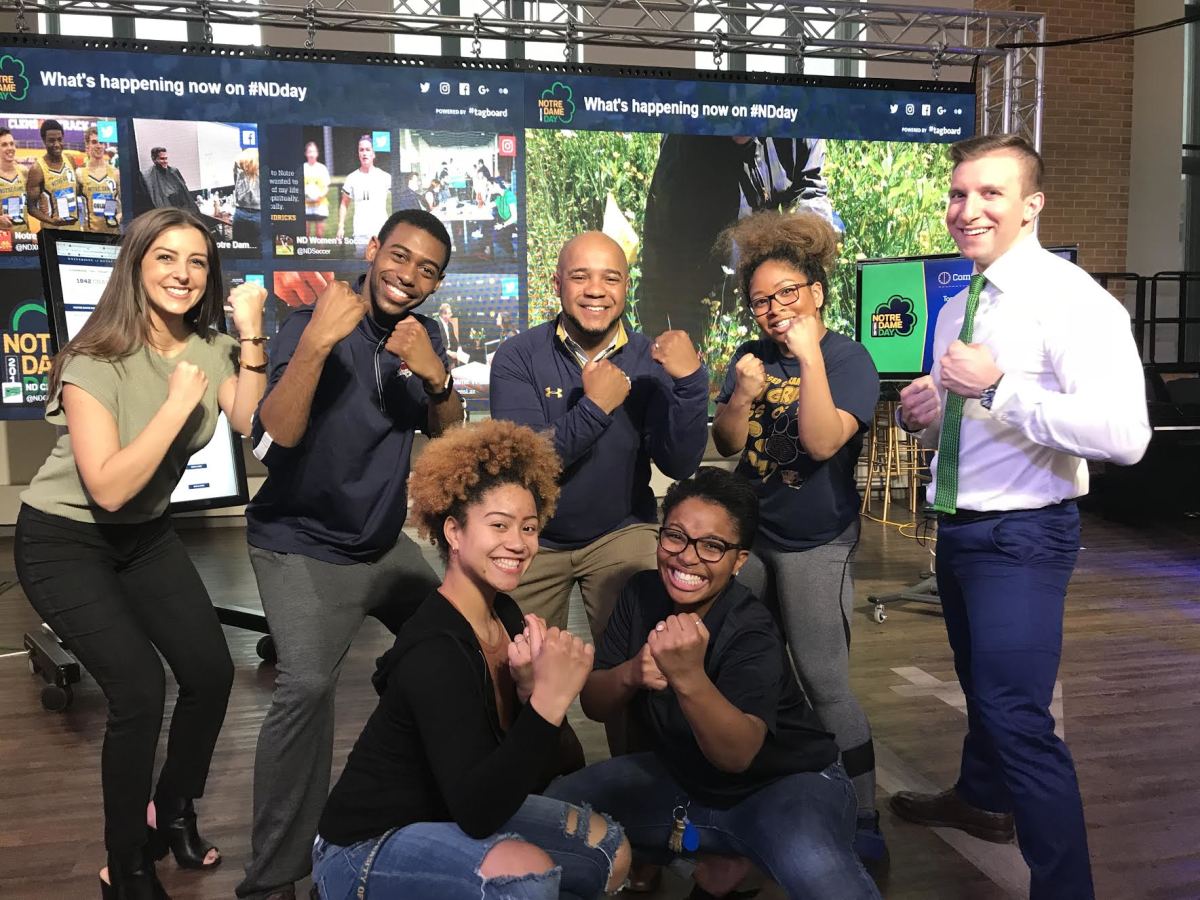At Notre Dame, Tradition Meets Progress Through Its Famous Leprechaun Mascot

Mike Brown was enjoying the festivities of Notre Dame Day, an annual fundraising drive, in the university’s Duncan Student Center when Samuel Jackson and a group of students met him last spring. Brown, who had been the leprechaun at Notre Dame during the ‘99 and ‘00 football seasons, talked to the small group of students about his experience as the first African-American leprechaun at Notre Dame. Afterwards, the group all posed together to take a photo, with their hands in fists and their knees bent, just like the leprechaun mascot.
Brown did not realize the significance of his conversation with Jackson at the time. “You could tell that all the students were active and engaged, but Sam [Jackson] just appeared different. He had an energy to him and a smile about him and I was like, ‘Dude, you should actually consider trying out.’ And he was like, ‘No way...no way.’ And I was like, ‘Dude, I’m telling you, you could do it.’ And he said, ‘Don’t you need a beard?’ And I said, ‘No way, you just need some energy and spirit and passion and just go after it!’ Little did I know, he actually thought about it and did it.”
Jackson now describes that conversation as “miraculous.” This fall he became just the second black leprechaun to cheer at Notre Dame. He also won the coveted position of cheering on the sidelines during Notre Dame football games, just like Brown did. Jackson debuted on Labor Day during primetime, dressed in the classic kelly green leprechaun suit for Notre Dame’s opener against Louisville. While he waved a massive monogram ND flag, led cheers, and did push-ups for every point scored during the game, his phone buzzed from friends and family, who sent him photos of himself on ESPN.

“I received a ton of photos, a ton of snapchats, you can basically name the social media platform,” Jackson said. “I received a lot from my friends who were really, really supportive. It’s really great to get that support from my friends and people I don’t even know.”
But amid receiving endless congratulations from friends and supporters, racist messages circulated on social media about Jackson’s presence on the sideline.
Jackson, who declined to comment to SI about the backlash he received, sent a tweet from his own account the day after the game, saying, “Like it or not, this guy right here is still one of your Notre Dame leprechauns! How about we use this negative energy to bring us together this season? See y’all next game #GoIrish”
Notre Dame’s first football season was in 1887, but the leprechaun mascot, as a human on the sidelines, did not exist until the 1960s. Like any exam at Notre Dame, the leprechaun selection process is extensive and thorough. Each year, dozens of students try out for only three spots on the roster. They submit written applications, turn in letters of recommendation, perform an improvisational mock pep-rally and answer questions from a selection committee.
Despite popular belief, there are no requirements to becoming the leprechaun. Any student can try out, regardless of their ability to grow a beard or how much they look like the short, mythical, cartoonish leprechaun stitched into quarter-zips in Hammes Bookstore. This year’s trio of leprechauns is Notre Dame’s most diverse in history. Lynnette Wukie, who cheers at volleyball and soccer games, is the first female leprechaun and is mixed race. Conal Fagan is the first native Irishman, hailing from Derry, Northern Ireland, to earn a spot as a leprechaun.
Congratulations to the new Leprechauns joining our #NDFamily.
— The Notre Dame Leprechaun (@NDTheLeprechaun) April 16, 2019
☘️ Samuel Jackson
☘️ Conal Fagan
☘️ Lynnette Wukie
🔗 https://t.co/MvKQnLXOpi#GoIrish pic.twitter.com/3Mm2sPQ51o
Wukie was the only woman to tryout this year, though others have tried out in the past. She describes herself as loud and passionate for Notre Dame athletics. One of her favorite parts of being the leprechaun is talking to fans, especially kids, she says. “There’s something really special about not having a [mascot] head on because you can talk to people.
“It’s so funny to see kids come up and be in total awe—it’s not me, it’s the leprechaun—so I think that getting to represent something like that is really special and actually getting to talk to them instead of just wave is a lot of fun.”
Wukie believes that the leprechaun mascot should reflect the makeup of the student body. “It opens people’s eyes to everything that the Notre Dame tradition is. If you walk around campus you see how diverse our whole student body is and how diverse our alumni is and us getting to be the leprechauns really shows that, but also I don’t think it was a planned move to say, ‘Oh, look how diverse Notre Dame is.’”
Mike Brown, who now sits on the leprechaun selection committee, says there was no intentional decision to make this group of leprechauns the school’s most diverse. “There are some people who may think that some statement was trying to be made by the university in selecting these three people and that could not be further from the truth.”

Jackson, Wukie and Fagan earned their jobs as this year’s leprechauns because they were the best people for the job, but the identities they represent should still be celebrated. Understanding that this group of leprechauns is as deserving as groups in the past, while celebrating their differences is key to understanding theories of representation in media.
Chris Becker, an associate professor of Film and Television Studies at Notre Dame, suggests, “Seeing people of color, their faces on television, in places that have been predominantly white, that’s important and matters, that starts conversations. But I don’t think we can end with that.”
Jackson, Becker says, isn’t just like any other leprechaun. Being able to have a conversation about his identity and about cultural differences is something that should happen and can open up a wider conversation about identity at Notre Dame and at other institutions.
The University of Notre Dame, and specifically, Notre Dame football, uses its long, storied tradition as a selling point in recruiting, raising money and branding. Notre Dame football players have worn virtually the same uniform with glittering gold helmets for more than 80 years. The team has played in “The House that Rockne Built” since 1930. When the university finally added a video board to the stadium in 2017, some fans were concerned it would alter the traditional game experience. Now during games, young and old fans cheer while the video board displays footage from Notre Dame victories decades ago.
As Jackson tweeted, like it or not, this year’s group of leprechauns are here to stay. Or as he put it to SI, “Progress and tradition are not mutually exclusive.”
